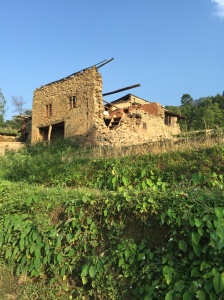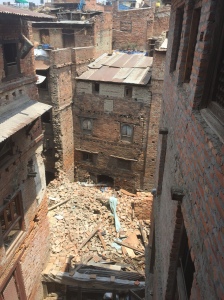As we were driving towards Dhading, the main road suddenly crowded with people, some anxiously looking towards the buildings and other agitatedly talking on their mobile phones. An aftershock of magnitude 4.8 had just struck and people had run outdoors! There have been more than 49 aftershocks that have measured over 4 on the Richter scale (two over 7, two over 6, 16 over 5, and 29 over 4; anything below 4, which are in the hundreds, are not reported). Meena Pokharel and Rudra Bhattarai from the National Agricultural Cooperative Central Federation Limited (NACCFL) and Babul Khanak from the National Cooperative Federation of Nepal (NCF/N) who were with me in the jeep immediately were on the phone checking the whereabouts and welfare of their immediate ones. Rudra Bhattarai told me, “You can well imagine our mental state. A month after the first big one and two weeks after the second, we are unable to get our lives back in order. Just as we feel it is okay to go back to normal life, whatever that means, we get jolted.”
Dhading district borders Kathmandu and would be less than 20 miles as the crow flies. However, given the mountainous terrain and road conditions it can take time to travel from one place to the other. Some of the villages in Dhading bore the brunt of the brunt of the earthquake as they were close to the epicenter. The first village we visited, Jiwanpur was a wreck. We could see many crumbled houses, partly crumbled houses, and a few standing erect. Next to these were new temporary structures, some had polythene sheets for roof and others corrugated iron. The Small Farmers Agricultural Cooperative Limited’s (SAFCL) building was erect but the adjoining building that housed staff had collapsed. Luckily no one was hurt. The chairman, Ramesh, a school teacher, told us, “In the VDC (a Village Development Committee is the lower administrative body whose purpose is to organize village people at a local level and to create a partnership between the community and the government for improved service delivery system) out of the 2,400 houses, there are only 24 that are livable. Many houses from the outside will look okay, but they have developed cracks and people are afraid to stay in. We received some relief from NACCFL and a local NGO. That is it.” All schools here, like in the rest of the affected districts, have been shut till the end of the month as many have been damaged and those that are livable are being used to house some of the displaced people. The next village we went next was Chhatre Dyaurali. The story here was very similar with 90% of the houses damaged and livestock affected. Mr. Krishna Luitel, the chair of the society said, “We used whatever material we have to reconstruct our houses. We are considering giving loan out of the society funds to help members purchase material.” The main source of livelihood, agriculture was ongoing and the villagers were continuing to harvest vegetables and supply to Kathmandu and other places. It was a poignant sight to see in many place doors placed on the road with no walls to support.
I visited NCF/N on May 20 morning and was met by Chairman Mr. Keshav Prasad Badal . The first thing he showed me were the cracks that had developed in the exterior walls of their new building, inaugurated a year back. As we walked up each floor and into each room, there were visible signs of the effects of the earthquake. Mr. Badal said, “there are cracks in many places but the structural integrity is preserved, so we are okay. I can’t say the same for thousands of others.” NCF/N represents around 27,000 cooperatives throughout the country that cover 4.7 million individual members. They have 18 central level cooperative unions (consumer, savings and credit, dairy, agriculture, bee keeping, vegetable and fruits, citrus, tea, sugarcane, health, coffee, herbal, electricity, multipurpose, information and communication, fishery, seed and tourism), one National Cooperative Bank, 302 District level cooperative unions and 12 associate members.
In my meeting with NCF/N staff and board, I was given an overview of the magnitude of the situation and the work NCF/N board, staff and members had carried out. Within an hour of the quake hitting, NCF/N had put out an appeal to all its members to help. Across the border, IFFCO in India was on the ready. In a telephonic conversation between Mr. Badal and Dr. Awasthi, MD of IFFCO and Mr. Aditya Yadav, Global Board member of ICA, a plan was worked out to send 10,000 packets of relief materials as an immediate response. The packets meant for one family had enough provisions (polythene sheet, mat, blanket, dhoti, saree, rice, pulses, sugar, salt, roasted gram, turmeric powder, tea, milk powder, pickle, matchbox, candle) to meet a week’s requirement. The packets were packed in one of IFFCO’s facility in India and transported in trucks across the border. They were received by NCF/N staff and after clearing customs were distributed in the affected districts In most of the cases, the materials were distributed through the District Cooperative Union and District Administration Office and Central Disaster Relief Committee. NCF/N is in the process of consolidating the data from affected districts that have been coming in from its unions. According to the numbers they have over a 1,000 cooperative members have been killed, 50,000 injured and over thousands of cooperative offices and member houses damaged.
In the afternoon, I visit NACCFL. NACCFL is the umbrella organization of SFACL. There are 611 SFACLs in 68 districts across the country with over 615,000 members. The mission of NACCFL is to provide appropriate non-financial services to their member organizations for institutional and socio-economic development. A survey by NACCFL showed that 440 members were killed and 925 injured; 72 SFACL offices damaged; 85,000 houses collapsed; 30,000 houses damaged and 145,000 livestock had perished.
NACCFL through the support of its members has provided relief packets, medicines, and rescued people out of debris/ rubble from 85 VDCs. Their second phase efforts will be focused on construction (office, warehouse, members, livestock), income generation activities, distribution of seeds, purchase of livestock, and training. NACCFL’s proposal is available for those who are interested.
The most dramatic visit was to the historic city of Bhaktapur. On my previous visits, the place was crowed with tourists and a hub of activity. This time around tourists could be counted on finger tips and normally bustling cafes bereft of customers. We visited the office of the local Samuhik Savings and Credit Cooperative Society (SACOS). The office and neighboring buildings were badly damaged. Four weeks after the quake and massive community cleaning, the place still resembled a war zone. The back room on the second floor where the bank was located was damaged and so operations were moved to the ground floor. Dhanesh the secretary told me, “ We quickly reconfigured the office to make space for operations to resume. We did not want our members to suffer. Also starting work gives us a feel of normalcy.” The managing committee of the SACOS recently met at the house rented by the President (his house had been damaged) to work out next steps. They have decided to defer penalty on late payment, provide relief to members (including child savers) who died and work out ways to provide reconstruction loans to members. They have collected data and provided it to their national federation.
The onset of monsoon in three weeks time poses a serious threat to people’s livelihood, dwellings, sanitation and health. The government has declared a state of emergency and asserted its monopoly on spending for reconstruction through the Prime Minister’s relief fund. The government, so far, has been unable to coordinate and remove bottlenecks in delivering aid. Most people want to begin constructing their houses with their own resources and support from the local initiatives. In order to carry out construction activities, our cooperative members will need to work in coordination with the government. The ICA national members with their national presence and broad reach to the village level have a significant role to play to influence the government and channel the reconstruction efforts. This will be a major task in front of them. They could consider providing loans to members to carry construction work directly. Providing aid for income generation activities, purchase of livestock and supply of seeds and other inputs are other possibilities. On the international front, our members have been supportive with their donations. In addition in-kind donation and technical assistance could be considered.
I met Dr. U.S Awasthi at his office today to thank him and IFFCO for their quick response. He said cooperatives have to come to the aid of cooperatives and we have done just that. I told him that our members in Nepal were looking at distributing seeds and looking for their support. Dr. Awasthi’s response, “we have done that!”



